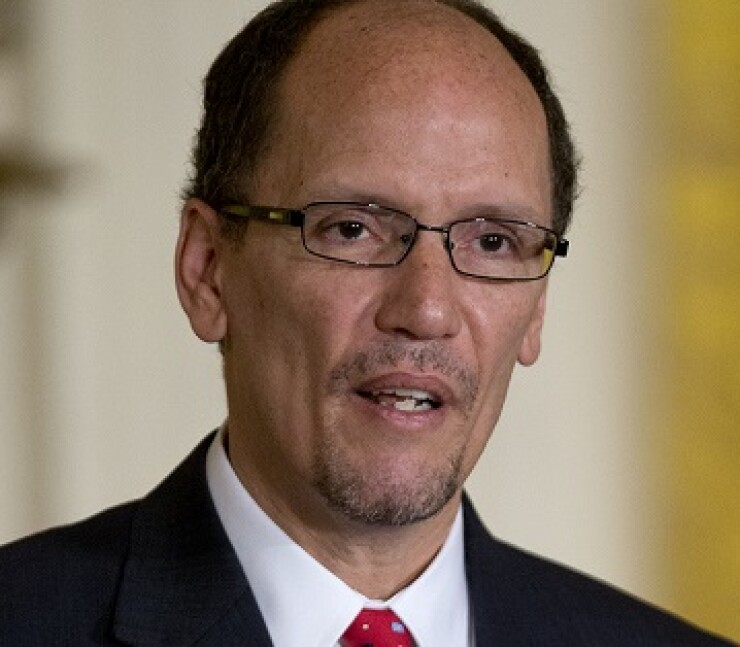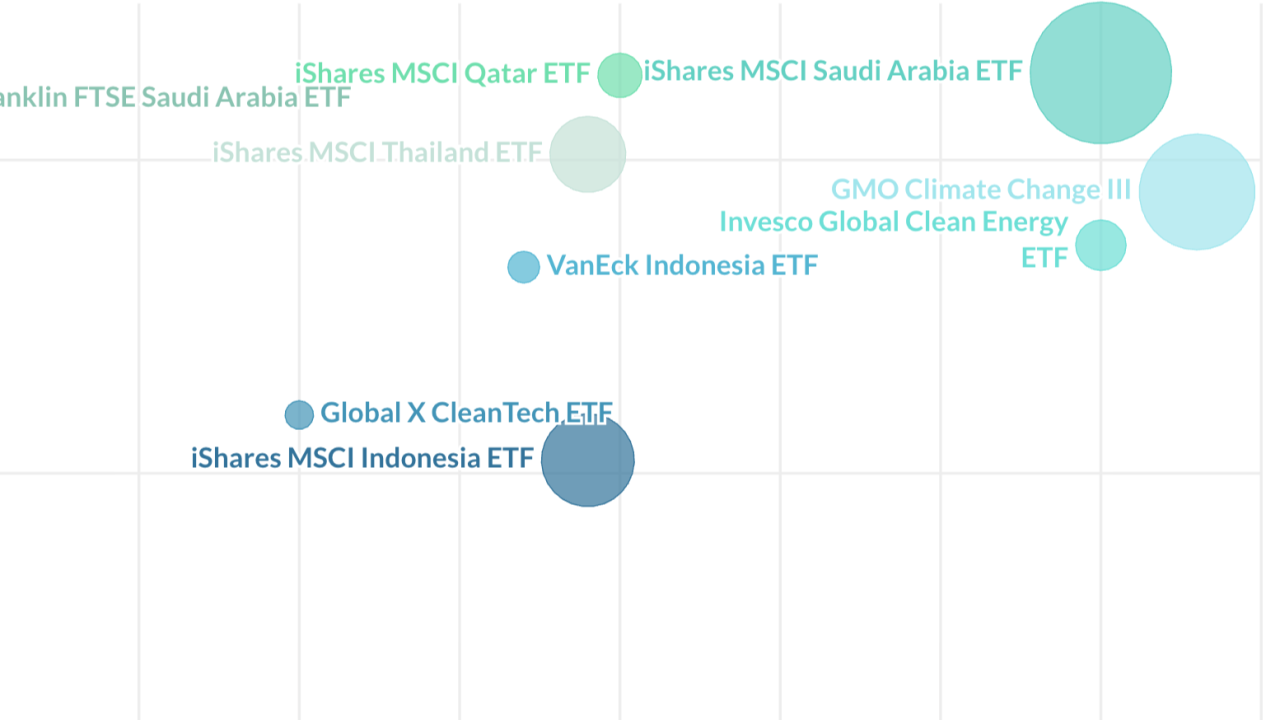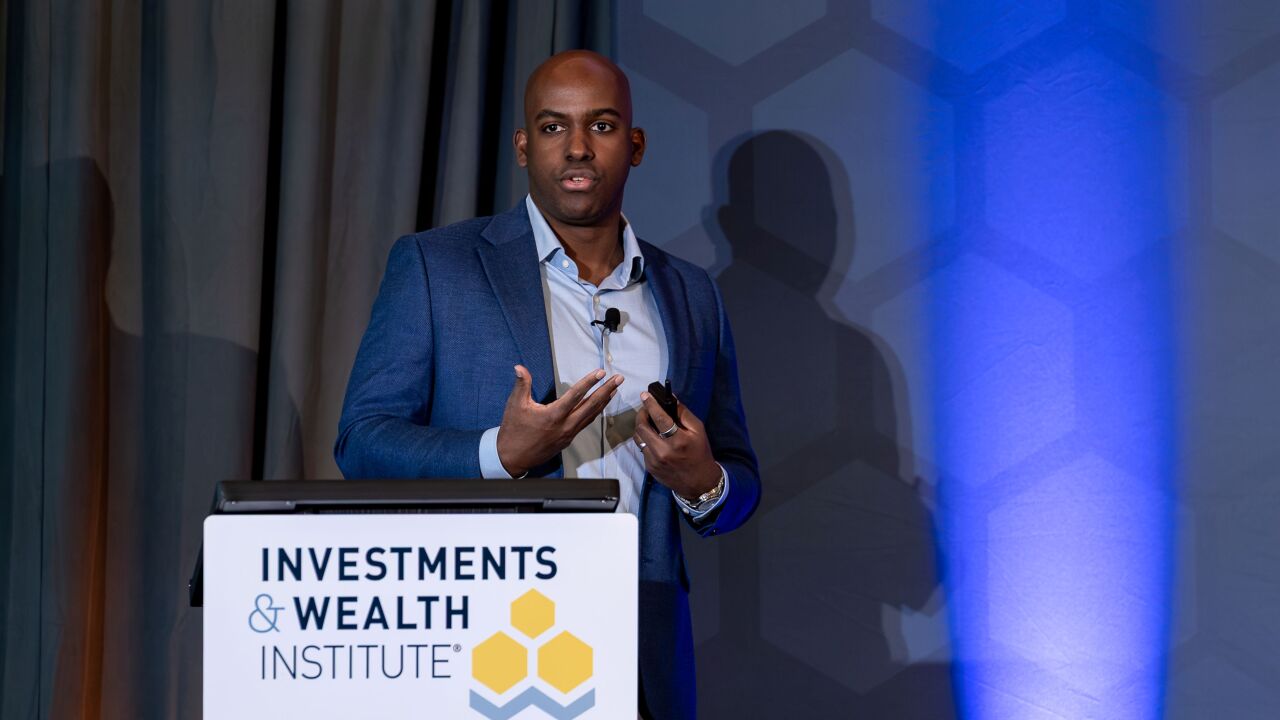
Most asset managers say they are still studying the the impact of the Labor Department’s fiduciary rule on asset managers, even though it was unveiled in April. Such is the impact of regulation on the state of asset management this year.
All product providers have been forced to assess the fiduciary standard and examine how it impacts their product offerings, as financial advisers revamp their practices and emphasize products that conform to the standard. “I have done more compliance in the past two years than I could have imagined,” says Lisa Shea, senior product manager at Northern Trust.
Also weighing on the industry is the continued encroachment of digital advice providers into traditional product space.
Robo adviser Wealthfront in June announced the launch its own tax-advantaged 529 account. Asset managers have in turn invested in digital providers; the latest being Eaton Vance’s $33 million investmennt into digital platform SigFig.
Money Management Executive spoke with Shea, Jeffrey Sherman, deputy chief investment officer at DoubleLine Capital, Andrew Rogers, CEO of Gemini Companies, and Sean Collins, senior director of industry and financial analysis at the Investment Company Institute, to get their perspectives on the state of asset management.
REGULATION
Lisa Shea, senior product manager, Northern Trust
What are some of the biggest challenges you have faced this year regarding regulation and compliance?
With all the regulatory focus and proposals that are on the table, I have done more compliance in the past two years than I could have imagined. If you look at the number of proposals at the various stages of rulemaking, it’s clear and consistent that the SEC was very upfront in stating its priorities: investor protection, education and risk mitigation. Every one of the proposals that have come out supports the same themes. If you look at one in isolation, it’s easy to get caught up in specific details. If you look at them as a package, it’s easy to see the trend and the pattern. We’re spending a lot of time looking at what’s in the proposals, thinking about the plan for how to prepare, how to help our clients prepare, understanding the impacts and the intentions, and really thinking ahead but not going too far down the road, because we don’t actually have final text for most of these. We have to be very thoughtful about the process, about the spirit, and really understand the intention to prepare, so that when the final text is issued, we can review and execute.
From a services perspective, what types of changes have you seen at Northern Trust?
We do think that the product lineups are going to start shifting. If you look back, I actually pulled out of the file with the dust; the 12b2. So, 12b2 kind of went quiet and there were a lot of comments from the industry. They were going to rescind 12b1, implement 12b2, but it has almost shifted away from that concept of changing the rule, instead we are changing all of the fiduciary obligations around selling the funds, and what is going to happen to the 12b1s? In the meantime that will be interesting to see. Between the distribution and guise guidance, the fiduciary rule that’s going to discourage retirement fiduciaries from selling something with a trailed commission, it’s going to be a change in the fund lineups.
PRODUCTS
Jeffrey Sherman, deputy chief investment officer, Doubleline Capital
In which investment area or asset class do you foresee the biggest opportunities for new investment products?
For starters, in the equity space, I expect further reduction in active management until it reaches equilibrium with passive/smart beta — the point where the surviving active equity managers actually produce alpha net of fees. In the fixed income space one can reasonably expect more active ETFs.
So-called liquid alts face an existential, perhaps insurmountable hurdle: how do you make an illiquid investment which collects liquidity risk premia more liquid? My base-case is renewed interest is commodities. With runaway monetary expansion, ECB corporate bonds purchases and BOJ equity investments investors are concerned about the potential for inflation.
Commodities have a positive historical correlation with unexpected inflation. Furthermore, commodities are one of the few asset classes trading at low prices relative to historical levels.
So you have attractive price, inflation protection and diversification. We believe there’s a place for new products that use the lessons of the past 20 years to create optimal commodity portfolios.
One of these improvements is roll optimization to avoid periods of contango that drag on total return. One could also expect new products to try and reduce the volatility and drawdown of commodities by implementing risk control strategies. Blending a long-only, roll-enhanced commodity index with a long-short strategy can reduce volatility and harvest convenience yield during times of commodity dislocation.
INNOVATION
Andrew Rogers, CEO, Gemini Companies
How will innovation impact the fund industry in the year ahead?
The mutual fund industry is experiencing deep changes in many areas of risk management and distribution that could create disruptions, opportunities, and innovation. The area of risk management is highlighted in the derivative rules proposed by the SEC.
With the formation of liquid alternatives, leveraged products, and proliferation of derivatives in many investment companies, the SEC is concerned about the potential of systematic disruption within investment companies. The industry will need to create systematic ways to measure risk and service providers will need to partner with investment advisors to create robust risk reporting that satisfies regulators and boards.
In addition, the proposed rule contains the creation of a chief risk officer that would report risk management to mutual fund boards. I believe the CRO and the management of risk will be elevated to the same level of management as the CCO and the compliance program.
With the addition of robo advisers we could see the growth of mutual fund sales through technology platforms. The next generation of investors seem less concerned with in person meetings and are increasingly comfortable with receiving information through various technology platforms. The next challenge for robo advisers seems to be how they will is to transform from basic questionnaires and allocation models into a community experience.
CHALLENGES
Sean Collins, senior director of industry and financial analysis, Investment Company Institute
Can you discuss trends you see developing regarding fee pressure in 2015?
We’ve noted a couple of important trends in recent years: strong growth in the number of fund sponsors and assets, both domestically and globally, and a continuing decline in mutual fund expense ratios.
In the U.S., our data show, new fund sponsors coming into the industry have been an important source of change. Since 2009, the number of fund sponsors has grown by 190, with new sponsors taking different forms. Some have come into the industry through a series trust, which is one way that a smaller asset manager can offer a mutual fund, using a turnkey operation. Others have entered as ETF sponsors. We’ve seen, on net, about 30 new sponsors offering only ETFs.
Looking at the industry globally, assets for what we call the regulated fund industry have increased by $12 trillion since 2009. About half of that increase came in the U.S., about a third in Europe, and the remainder in Asia-Pacific. But the Asia-Pacific region has actually shown the highest growth rate of these three regions — growing 75% during this period. One factor in that trend is the growing middle class in that region and its growing demand for regulated funds through retirement products. As the U.S. market has become more mature, asset managers have begun to look at the Asia-Pacific area and others with greater growth potential. We’re seeing a rise both in interest and the importance of entry into those markets to offer regulated funds to middle class investors there saving for retirement and other investment goals.
Finally, from our expenses and fees data for U.S.-based funds, one overarching trend in costs paid by investors remains clear; mutual fund expense ratios continued to fall in 2015, as they have done for at least 20 years. The decline, as in recent years, reflected two major factors: first, shareholders continued to shift assets toward lower-cost funds and, second, the expense ratios of some individual funds declined. No matter how you look at it, fund investors overall paid lower expense ratios.
Growth and competition in the registered fund space continue to invigorate the industry as it innovates to help millions of investors around the world meet their financial goals.
Most asset managers say they are still studying the the impact of the Labor Department’s fiduciary rule on asset managers, even though it was unveiled in April. Such is the impact of regulation on the state of asset management this year. All product providers have been forced to assess the fiduciary standard and examine how it impacts their product offerings, as financial advisers revamp their practices and emphasize products that conform to the standard. “I have done more compliance in the past two years than I could have imagined,” says Lisa Shea, senior product manager at Northern Trust. Also weighing on the industry is the continued encroachment of digital advice providers into traditional product space. Robo adviser Wealthfront in June announced the launch its own tax-advantaged 529 account. Asset managers have in turn invested in digital providers; the latest being Eaton Vance’s $33 million investmennt into digital platform SigFig. Money Management Executive spoke with Shea, Jeffrey Sherman, deputy chief investment officer at DoubleLine Capital, Andrew Rogers, CEO of Gemini Companies, and Sean Collins, senior director of industry and financial analysis at the Investment Company Institute, to get their perspectives on the state of asset management. REGULATION Lisa Shea, senior product manager, Northern Trust What are some of the biggest challenges you have faced this year regarding regulation and compliance? With all the regulatory focus and proposals that are on the table, I have done more compliance in the past two years than I could have imagined. If you look at the number of proposals at the various stages of rulemaking, it’s clear and consistent that the SEC was very upfront in stating its priorities: investor protection, education and risk mitigation. Every one of the proposals that have come out supports the same themes. If you look at one in isolation, it’s easy to get caught up in specific details. If you look at them as a package, it’s easy to see the trend and the pattern. We’re spending a lot of time looking at what’s in the proposals, thinking about the plan for how to prepare, how to help our clients prepare, understanding the impacts and the intentions, and really thinking ahead but not going too far down the road, because we don’t actually have final text for most of these. We have to be very thoughtful about the process, about the spirit, and really understand the intention to prepare, so that when the final text is issued, we can review and execute. From a services perspective, what types of changes have you seen at Northern Trust? We do think that the product lineups are going to start shifting. If you look back, I actually pulled out of the file with the dust; the 12b2. So, 12b2 kind of went quiet and there were a lot of comments from the industry. They were going to rescind 12b1, implement 12b2, but it has almost shifted away from that concept of changing the rule, instead we are changing all of the fiduciary obligations around selling the funds, and what is going to happen to the 12b1s? In the meantime that will be interesting to see. Between the distribution and guise guidance, the fiduciary rule that’s going to discourage retirement fiduciaries from selling something with a trailed commission, it’s going to be a change in the fund lineups. PRODUCTS Jeffrey Sherman, deputy chief investment officer, Doubleline Capital In which investment area or asset class do you foresee the biggest opportunities for new investment products? For starters, in the equity space, I expect further reduction in active management until it reaches equilibrium with passive/smart beta — the point where the surviving active equity managers actually produce alpha net of fees. In the fixed income space one can reasonably expect more active ETFs. So-called liquid alts face an existential, perhaps insurmountable hurdle: how do you make an illiquid investment which collects liquidity risk premia more liquid? My base-case is renewed interest is commodities. With runaway monetary expansion, ECB corporate bonds purchases and BOJ equity investments investors are concerned about the potential for inflation. Commodities have a positive historical correlation with unexpected inflation. Furthermore, commodities are one of the few asset classes trading at low prices relative to historical levels. So you have attractive price, inflation protection and diversification. We believe there’s a place for new products that use the lessons of the past 20 years to create optimal commodity portfolios. One of these improvements is roll optimization to avoid periods of contango that drag on total return. One could also expect new products to try and reduce the volatility and drawdown of commodities by implementing risk control strategies. Blending a long-only, roll-enhanced commodity index with a long-short strategy can reduce volatility and harvest convenience yield during times of commodity dislocation. INNOVATION Andrew Rogers, CEO, Gemini Companies How will innovation impact the fund industry in the year ahead? The mutual fund industry is experiencing deep changes in many areas of risk management and distribution that could create disruptions, opportunities, and innovation. The area of risk management is highlighted in the derivative rules proposed by the SEC. With the formation of liquid alternatives, leveraged products, and proliferation of derivatives in many investment companies, the SEC is concerned about the potential of systematic disruption within investment companies. The industry will need to create systematic ways to measure risk and service providers will need to partner with investment advisors to create robust risk reporting that satisfies regulators and boards. In addition, the proposed rule contains the creation of a chief risk officer that would report risk management to mutual fund boards. I believe the CRO and the management of risk will be elevated to the same level of management as the CCO and the compliance program. With the addition of robo advisers we could see the growth of mutual fund sales through technology platforms. The next generation of investors seem less concerned with in person meetings and are increasingly comfortable with receiving information through various technology platforms. The next challenge for robo advisers seems to be how they will is to transform from basic questionnaires and allocation models into a community experience. CHALLENGES Sean Collins, senior director of industry and financial analysis, Investment Company Institute Can you discuss trends you see developing regarding fee pressure in 2015? We’ve noted a couple of important trends in recent years: strong growth in the number of fund sponsors and assets, both domestically and globally, and a continuing decline in mutual fund expense ratios. In the U.S., our data show, new fund sponsors coming into the industry have been an important source of change. Since 2009, the number of fund sponsors has grown by 190, with new sponsors taking different forms. Some have come into the industry through a series trust, which is one way that a smaller asset manager can offer a mutual fund, using a turnkey operation. Others have entered as ETF sponsors. We’ve seen, on net, about 30 new sponsors offering only ETFs. Looking at the industry globally, assets for what we call the regulated fund industry have increased by $12 trillion since 2009. About half of that increase came in the U.S., about a third in Europe, and the remainder in Asia-Pacific. But the Asia-Pacific region has actually shown the highest growth rate of these three regions — growing 75% during this period. One factor in that trend is the growing middle class in that region and its growing demand for regulated funds through retirement products. As the U.S. market has become more mature, asset managers have begun to look at the Asia-Pacific area and others with greater growth potential. We’re seeing a rise both in interest and the importance of entry into those markets to offer regulated funds to middle class investors there saving for retirement and other investment goals. Finally, from our expenses and fees data for U.S.-based funds, one overarching trend in costs paid by investors remains clear; mutual fund expense ratios continued to fall in 2015, as they have done for at least 20 years. The decline, as in recent years, reflected two major factors: first, shareholders continued to shift assets toward lower-cost funds and, second, the expense ratios of some individual funds declined. No matter how you look at it, fund investors overall paid lower expense ratios. Growth and competition in the registered fund space continue to invigorate the industry as it innovates to help millions of investors around the world meet their financial goals.





